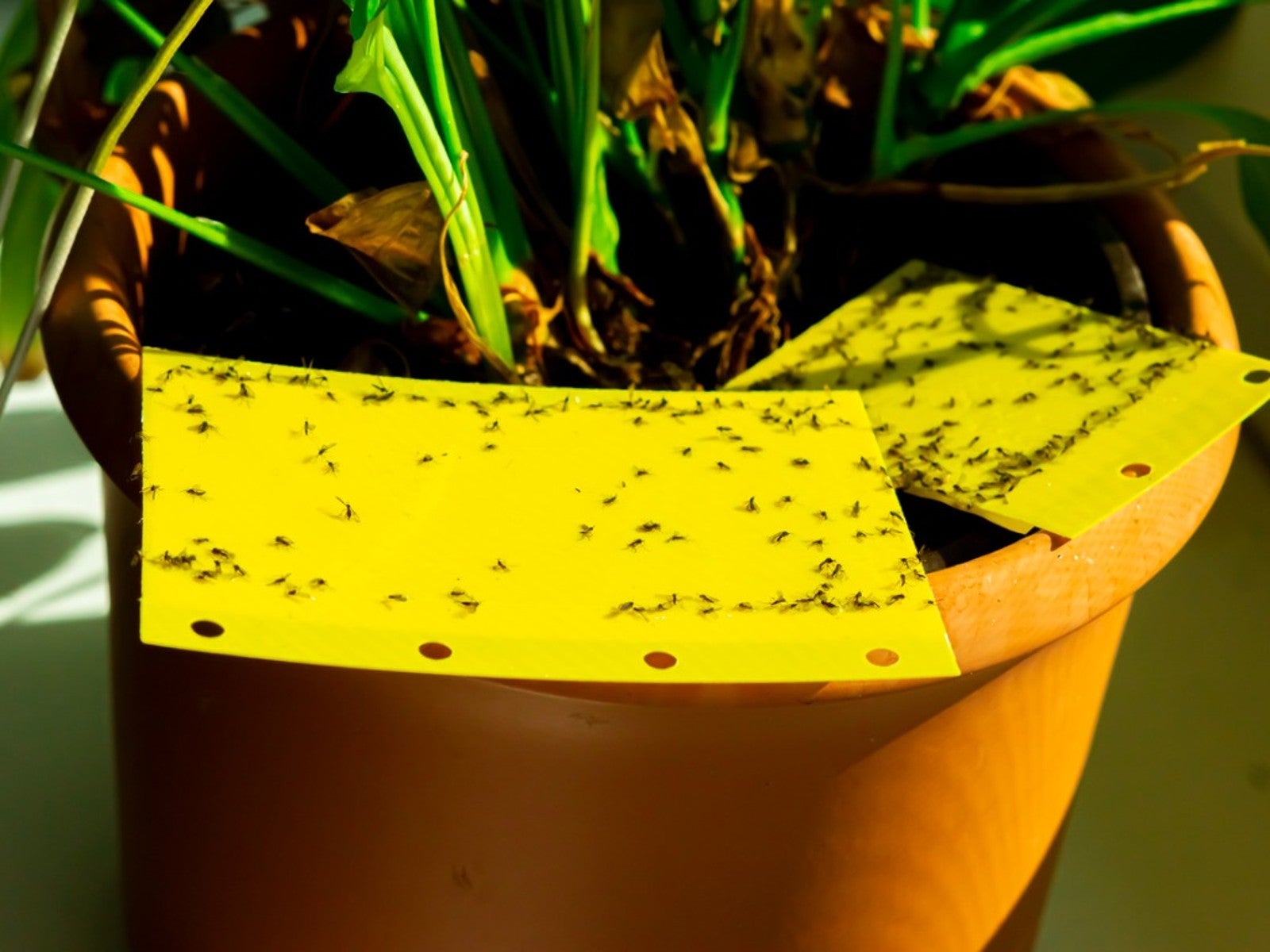DIY Fungus Gnat Trap To Keep Pests Off Houseplants

If you have an infestation of tiny bugs buzzing around your home, they may be fungus gnats. Harmless to humans but none the less annoying, you’ll no doubt want to get rid of fungus gnats. There are several methods of fungus gnat control, some more successful than others. Read on to learn about trapping fungus gnats in the home.
What is a Fungus Gnat?
Fungus gnats may be confused with fruit flies. The difference between the two is evident upon close inspection. Fruit flies have bodies that are perfect miniatures of the house fly, while fungus gnats have long legs dangling from an elongated body, much like a mosquito.
If you are still unsure what type of gnat you have, place potato slices on the surface of the soil of a potted plant. If fungus gnats are present the larvae will come to the surface to feed on the potato. You should be able to see fungus maggots after 3-4 days on the tuber slices.
Fungus gnats (Orfelia and Bradysia species) are dainty, dark flies much akin to mosquitoes. Adults have segmented antennae longer than their heads, which distinguishes them from shore flies, also often found in greenhouse environments.
Because adult fungus gnats are attracted to light you may notice them zipping around near windows. That said, fungus gnats are rather lazy fliers and more commonly found near or on potted plants.
Female gnats lay eggs in moist potting soil or organic debris. The resulting larvae are elongated with a whitish to clear legless body and shiny black head. They subsist on botanical organic material like your house plants.
How to Control Fungus Gnats Early
Insecticides or biological controls can help to keep fungus gnats in check. The most effective controls target the larva and pupa. You could use an insecticide but there is some concern about spraying plants that will be living in your home.
Gardening tips, videos, info and more delivered right to your inbox!
Sign up for the Gardening Know How newsletter today and receive a free copy of our e-book "How to Grow Delicious Tomatoes".
The best way to control larva and pupa is to reduce conditions they are attracted to, primarily moist soil media. Keep the soil surface dry to eliminate egg-laying sites by allowing the first top inch (2.5 cm.) of soil to dry out before watering again Also water plants from the bottom to keep the surface dry yet still provide water to the root system.
Lastly, cover the soil with a layer of coarse sand of fine gravel which will not only help to keep the soil dry but make it less palatable for the gnats to lay eggs. Be patient. It may take 3-4 weeks of reduced watering combined with amended surface soil to get a handle on fungus gnats.
How to Control Adult Fungus Gnats
One of the most common methods of control is a fungus gnat sticky trap. Inexpensive and simple devices, yellow sticky traps for fungus gnats are laid on the soil surface to capture adult gnats.
Another option is biological control using Bacillus thuringiensis subsp. israelensis (Bti). Treatment using Bti doesn’t affect eggs, pupae or adult gnats. Instead Bti filters through the soil to reach larvae. Bti should be applied several times every 5-7 days to control newly hatched larvae.
Finally, there are some home remedies that may help control fungus gnat populations. You may have heard of or tried vinegar or wine traps but unfortunately, they only work for fruit flies.
An interesting side note is a study done with Bounce original scent dryer sheets. The study showed that these dryer sheets were effective in repelling fungus gnats. Why? Likely due to the ingredient Linalool, a common component in perfumes found naturally in lavender and basil.
Chemical Control for Fungus Gnats
If the problem is severe and nothing else has worked to eradicate the gnats, you may want to consider a chemical control. Look for insecticides that contain pyrethrins or synthetic pyrethroids, as well as one that is safe for use on indoor houseplants. Read and carefully follow the manufacturer’s instructions.
Apply to plants and their surfaces where adult fungus gnats rest. Do not spray into the air. Continue with non-chemical controls in conjunction with chemical controls.
Note: Any recommendations pertaining to the use of chemicals are for informational purposes only. Chemical control should only be used as a last resort, as organic approaches are safer and more environmentally friendly.

Amy Grant has been gardening for 30 years and writing for 15. A professional chef and caterer, Amy's area of expertise is culinary gardening.
-
 Try The Trend – Turn Any Bed Into A Keyhole Garden With This Clever In-Ground Composter
Try The Trend – Turn Any Bed Into A Keyhole Garden With This Clever In-Ground ComposterKeyhole gardening is an efficient and sustainable practice that saves space. Get started on this DIY project quickly and easily with an in-ground composter.
By Bonnie L. Grant
-
 4 Superfast Composting Methods: Turn Waste Into Garden Gold In 30 Days Or Less
4 Superfast Composting Methods: Turn Waste Into Garden Gold In 30 Days Or LessTry the fastest composting methods to turbocharge your pile and transform kitchen scraps and garden waste into finished compost in just a few weeks.
By Mary Ellen Ellis